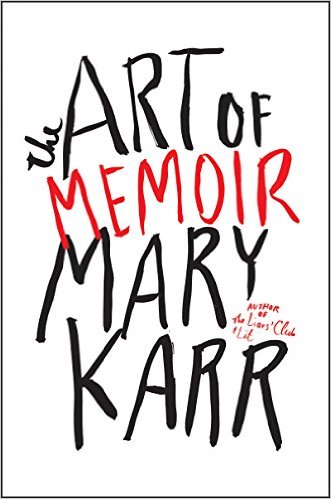Review by Hannah Straton
 The Art of Memoir by Mary Karr (Harper, 2015) is the kind of book that makes you want to read it voraciously, while at the same time reading all of the books it references, while simultaneously madly scribbling the ideas that keep popping into your head for your own book.
The Art of Memoir by Mary Karr (Harper, 2015) is the kind of book that makes you want to read it voraciously, while at the same time reading all of the books it references, while simultaneously madly scribbling the ideas that keep popping into your head for your own book.
Before writing The Art of Memoir, Mary Karr had to become versed in, well, the art of memoir. In the book, her steps and missteps are extensively and warmly recounted. She is the author of The Liar’s Club as well as two other bestsellers: Lit and Cherry. For thirty years Karr taught at the extremely selective program at Syracuse University and mentored, among others, Cheryl Strayed author of Wild.
In The Art of Memoir Karr combines practical advice with intangible wisdom, which fuses together beautifully to create a useful guide that also inspires. Her voice throughout the book makes for an accessible and enjoyable read and The Art of Memoir is geared toward both the serious memoirist and the beginning writer (and everyone in between).
Karr’s teaching technique is extremely effective and entertaining. At times she comes out and says what she wants the reader to learn, other times she forces the reader to infer the lesson (although she does always go back and reinforce), and still other times she uses excerpts from famous memoirs to do the teaching for her. The combination of these efforts makes The Art of Memoir an essential tool for all writers. Particularly helpful are Karr’s lists, such as this sample (in the book the list contains eleven items) of the following:
“For the record here are my rules for dealing with others:
- Notify subjects way in advance, detailing parts that might make them wince. So far no one has winced.
- On pain of death, don’t show your pages to anybody mid-process. You want them to see your best work, polished…”
However, there are other such times when the advice comes in less how-to form: “But memoir can compete against the pyrotechnics of visual imagery in film and TV only by excelling where those media fail: writing a deeper moment from inside it.”
Karr is the kind of writer who will set down a line such as that one and then, in the following paragraph, explain it perfectly without the reader ever having realized they have just learned a monumental literary concept because they were so wrapped up in Karr’s voice and style.
Karr does preface some chapters with notes and warning labels to acknowledge that the following chapter is not for everyone: “(Note—Again, the lapidary work here—intended for the practitioner—may bore the general reader.).” If you are not so much into the nitty-gritty of the inner workings of line-by-line revision, you know to skip that chapter. This is yet another way Karr sets out to help the reader get the most out of the book.
Karr writes very conversationally, even when discussing difficult subjects; whether intellectually or emotionally, the accessible pull of her style is undeniable. She adds humor to what might be otherwise dry material and diffuses tension with one-liners like, “One can’t mount a stripper pole wearing a metal diving suit.” Karr’s voice is unique, occasionally colloquial, sometimes snarky, never pretentious, and always engaging.
The only problem I have with The Art of Memoir is that it needs a title fitting of the book, not this one that makes it sound like a boring theory book, when in actuality it is a beautifully crafted, real life guide that is as useful as it is eloquent and gripping.
Rating: 5 out of 5 stars
[boxer set=”straton”]


